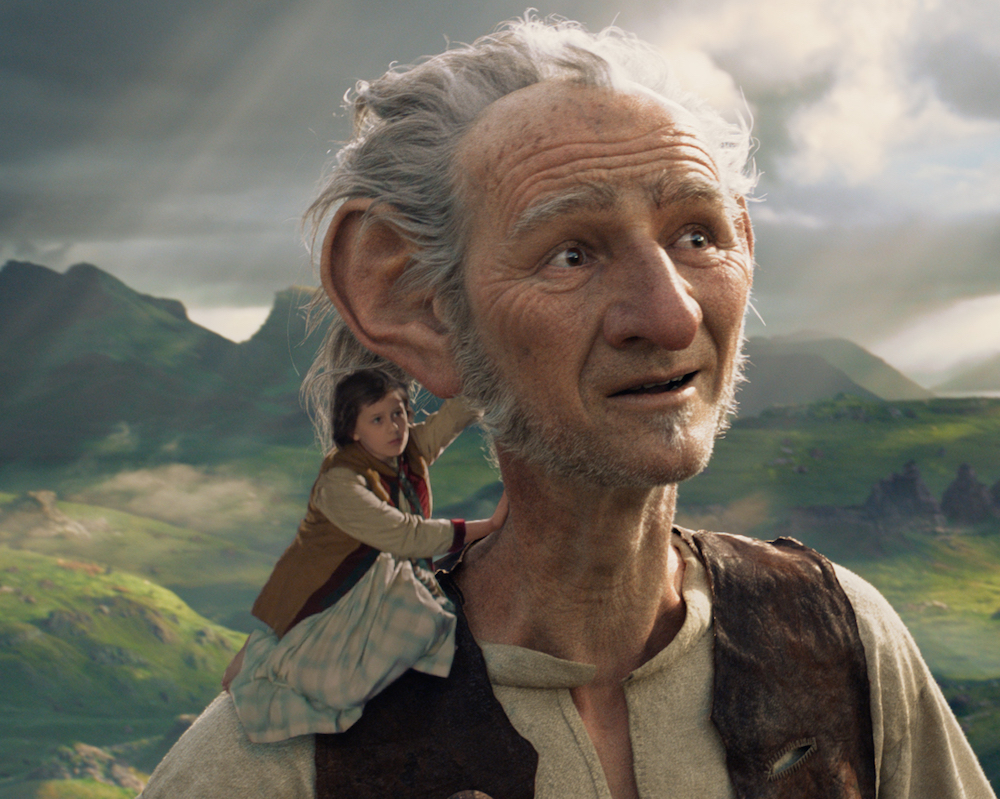
Sophie (Ruby Barnhill) is an orphan, living in the middle of a picture-perfect cobblestone diorama of midcentury England, who catches a glimpse of a giant. The giant spots her and snatches her away from her dreary life to be sure she won’t tell anyone of his existence.
But the giant (Mark Rylance) doesn’t intend to eat Sophie, as she fears he might—he’s a friendly giant, nameless other than the acronym BFG for Big Friendly Giant. His giant brethren, of which there seem to be only eight or nine, are less friendly and consider human meat a specialty. They’re nothing but bullying brutes who look down on the BFG as a “runt.” The BFG is all goofy smiles, folksy malapropisms (“puffers” for clouds, “strawbunkles” for strawberries) and nonsense words (“Bozgoppers, it’s a fizwizzer!”). Once the BFG opens up and Sophie begins to accept her new life away from the dreary orphanage life we know nothing about, the two form a close friendship, though that just seems to happen between scenes.
He eats nothing but slimy, grotesque vegetables and lives in a dark hovel with a waterfall and a secret room behind it, lit by nothing other than colorful glowing orbs in jars. These are dreams, which the BFG catches like fireflies in a world he can only reach by jumping through the surface of a magical pond and then disperses them among the human population.
The other giants sleep outdoors in a big pile and seem to exist only to bully the BFG when they suspect he has food, creating enough occasional conflict to distract from the fact that we know nothing about them or their ancient, apparently immortal civilization. The goofy third act finds the giant world and the human world colliding in a way that will only raise another thousand-plus questions and make adult audiences roll their eyes at a painful extended fart joke.
Such gaps in logic might seem less glaring in the children’s book the film was based on by beloved author Roald Dahl. But director Steven Spielberg—on paper the ideal filmmaker to bring the kid-lit classic to life—doesn’t give the film enough plot or interesting characters to compensate for its total lack of satisfactory world-building. The BFG is lovable enough, thanks in part to the vocal work from Rylance and the affectionate features of his design, but Sophie is a total blank slate, except when she’s just irritating in a know-it-all way that’s typical for so many child actors.
Since neither character has any real motivation or agency of their own, the story is just about non-existent. Sophie wants to be returned to her orphanage, until she doesn’t. The BFG is afraid to stand up to his bullies, until he isn’t. The film instead has the episodic nature of a kid’s book, where each scene exists only to show off some new CGI spectacle or deliver a half-baked heartwarming message.
For his return to spectacle-based family filmmaking after a couple stellar historic prestige pics, Spielberg could have learned a few lessons from his early output like E.T. or Jaws, which created intrigue and wonder by injecting an element of the fantastic or the terrifying into idyllic, often mundane settings. Spielberg can only recapture that wonder visually in The BFG, as he does in a few amazing setpieces (one when Sophie is first abducted, and another when she scurries across the multi-tiered contraptions of BFG’s house while the other giants search for her) that use Sophie’s perspective to show the enormous scope of Giant Country, but he lacks the restraint to sustain those awe-inspiring heights for the whole film.
While Spielberg achieved greatness with Jaws by showing as little of the crummy shark effect as possible, here he has so much excessive CGI at his fingertips that his effects, which should be fantastical, become numbing rather than enchanting within the first ten minutes. The BFG himself is a great effect with personality, even if he does appear a little weightless at times, but everything else is just excessive and tiring. The rainbow fireflies they call dreams especially never come close to being convincing.
Not only is The BFG is lousy with eye-popping CGI, even the supposed real world is nothing like reality as we know it. The unassuming suburbia of E.T. is replaced by a cityscape just as fantastical as the verdant rock formations of giant country. It dulls the contrast and makes Sophie even less compelling—why would she be so eager to escape such a beautiful place? Maybe Spielberg was a little too eager to enchant and forgot how to do it properly, in this case, or maybe he wasn’t as invested in his source material as he could have been. Ultimately, his film feels weightless, like nothing more than an exercise—and in spite of a few good cinematic workouts, this exercise is just as boring and uninvolving for the observer as any other.


